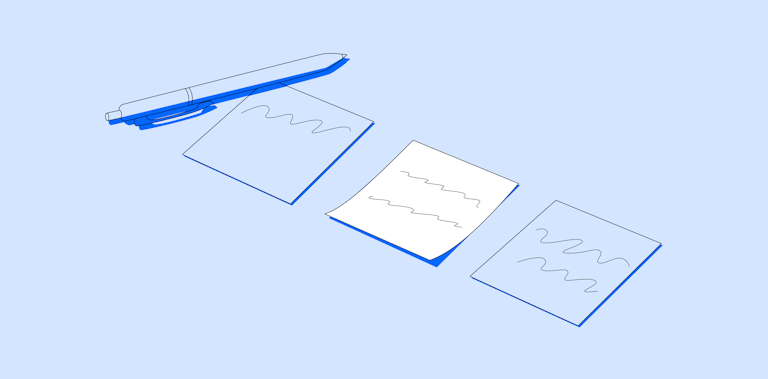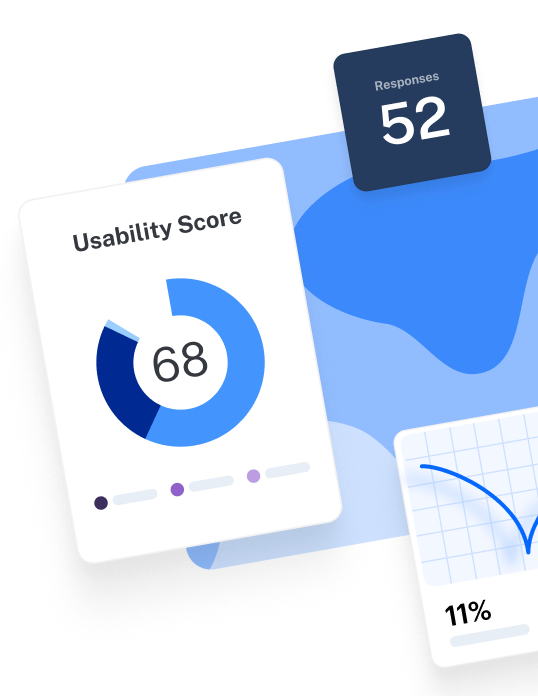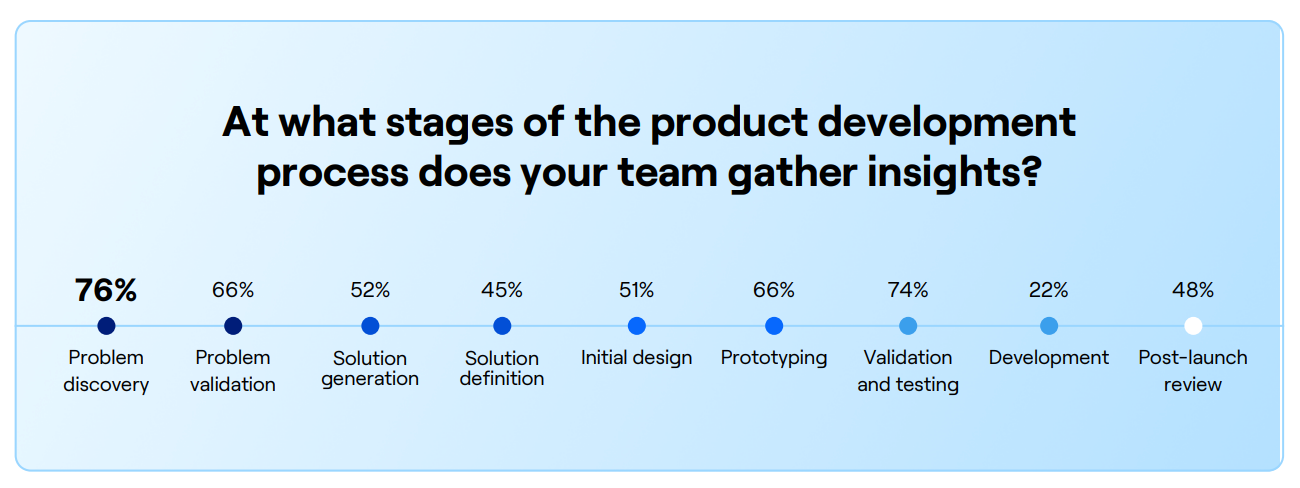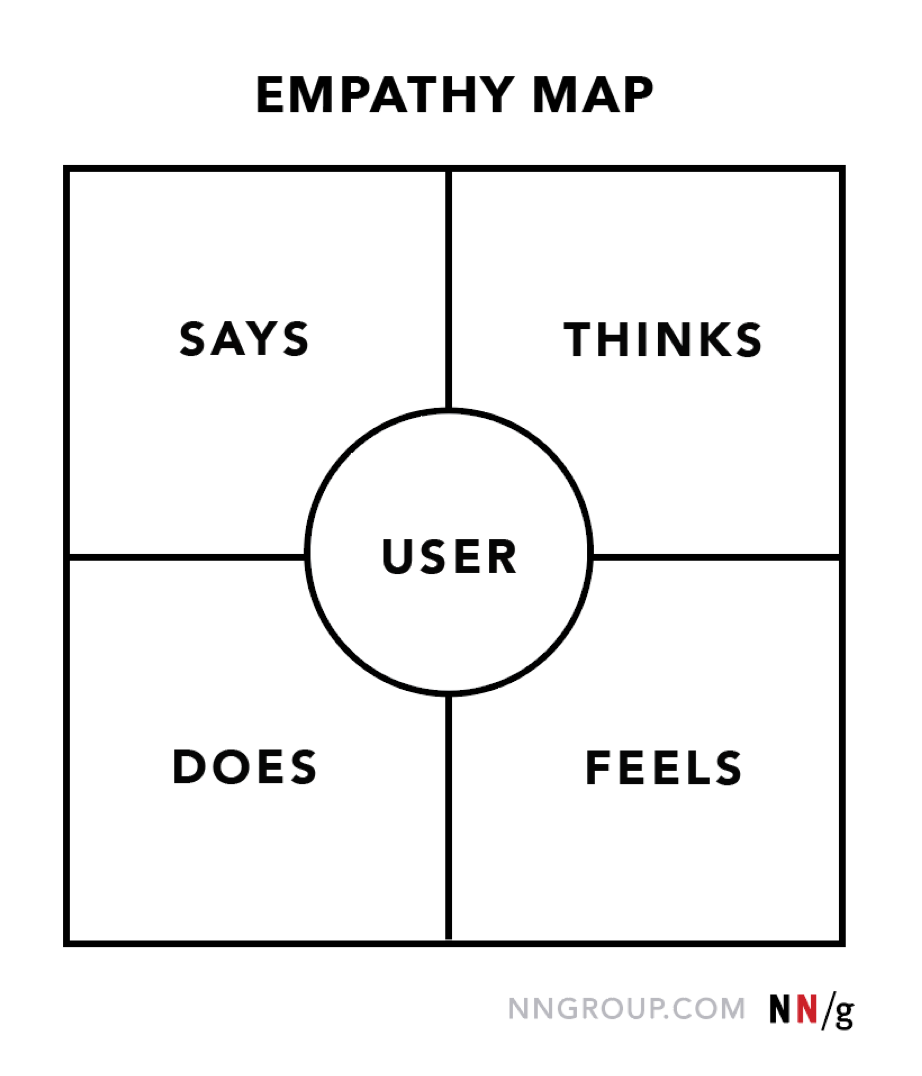Chapter 3
How to write user interview questions (with 30+ examples)

Ever heard the phrase “you’re only as strong as your weakest link”?
When it comes to user interviews, you’re only as strong as your weakest interview question.
No matter how engaging an interviewer you are, you won’t uncover the right insights without asking the right questions.
In this chapter of our user interview guide, we’ll share how to write interview questions that elicit relevant, in-depth insights. And, in case you’re stuck for inspiration, we’ve also got 30+ examples to inspire your next user interview question brainstorm.
How many questions should be in a user interview?
It’s less about how many questions, and more about how much time.
For example, you could whizz through 20 questions in 20 minutes and have gleaned nothing from your interview. Or, you could spend 40 minutes running through four questions and get deep insights into what you’re researching.
The duration of your user interview depends on factors like the subject matter, participant communication style, and question type. The same four questions that took 40 minutes with one participant may only take 20 with another.
Hillary Omitogun, UX Research Consultant and Founder of HerSynergy Tribe, shares the time she sets aside for different types of interviews:
“I prefer to keep discovery interviews within a 40 to 60-minute range. This prevents participants from becoming tired or giving answers they think I want to hear just to end the session sooner.
“For continuous interviews, which are often more regular and slightly less comprehensive, I�’ve found a duration of 20-30 minutes is ideal.”
As Hillary mentions, you need to be mindful of not exhausting your interviewee through extensive questioning.
The average human attention span is 8.25 seconds, with a general range from two seconds to a maximum of about 20 minutes. This is a big difference between individuals, so it’s not a case of one-size-fits-all. With interviews, your users are expending attention on answering your questions, potentially leading to fatigue and negatively impacting the quality of answers. Bear this in mind when prepping your questions, and remember that in the case of user interviews: less is often more.
3 Types of user interview questions (with examples)
User interview question types can be divided and grouped in various ways—by objective, research scenario, point in the product journey, to name a few. We find it’s easiest to fit user research questions into three broad categories centered around your research focus:
- Problem
- Person
- Product
We’re focusing on open-ended questions rather than close-ended questions—like yes\nos and Likert scales—which are more common in UX surveys. This is because interviews as a UX research method are ideal for gathering descriptive feedback and in-depth qualitative data, by providing the space and time for follow-ups and probing.
Let’s start with our first P: the problem.
User interview questions about the problem
User interview questions about the problem help you understand pain points, identify friction, and figure out potential solutions for the issues participants encounter. They’re how you hone in on the problem to create a user-focused solution.
Examples of problem-focused user interview questions:
- What is your personal measure of success when it comes to [goal]?
- When you do run into problems with completing [task] how do you solve them?
- What’s the most frustrating part of solving your task and why?
- How often do you encounter problems when dealing with [task]?
- What are some things that have made completing [task] easier beforehand?
Haley Stracher, Design Director and CEO at Iris Design Collaborative, shares a couple of her go-to questions about user problems:
- "Did you encounter any difficulties while completing [task]?"
- "Did you encounter any delights while completing [task]?"
It’s important to gather balanced feedback, so asking users to highlight positives as well as the negatives can help hone in on a problem, and identify additional details.
User interview questions about the people
Asking your users about themselves gives you insight into who your users really are. By asking open-ended questions you’ll understand how they think, how they adopt and use products and features, and what they want and don’t want.
Your people-oriented interview questions should help you form a clear picture of users' mental models, giving you a better understanding of how to position and update your product and features to best suit their needs. People-centered questions are also ideal when building out your UX user personas.
Examples of people-focused interview questions:
- How do/did you decide on a product or service for completing [task]?
- How big of a role does [completing task] play in your day-to-day?
- How often do you complete [task]?
- Describe your typical processes for completing [task].
- How do you prefer to learn to use new products?
Haley also recommends asking:
- "Which feature or functionality did you feel was the most important to you?"
- “Do you feel that our product provides value for the price you pay?”
Both questions about problems and people give you a 360° view on your users; helping you better understand who they are, their jobs-to-be-done, a healthy amount of friction for their learning curve, and the challenges they encounter on their journey.
User interview questions about the product
With the questions above you’ll know who your users are and what problems they face. But if you really want to knock it out of the park with your interview questions, you’ll also need to ask plenty of questions about the product itself.
This is where you can dive into the nitty-gritty technicalities. Questions about the product should focus on specific touchpoints, features, and interfaces. These questions can focus on anything from existing usability to desired features. Product-focused questions ensure that every UX design decision is insight-driven and user centric.
Examples of product-focused questions:
- In what ways is the product lacking ? In what ways can it be better?
- How could the product interface be easier to navigate?
- What changes in the product would help you complete [task] with less effort?
- How satisfied are you with using the product to complete [task]?
- Are the certain features you expected the product to have, but did not?
Haley provides extra options from her experiences connecting with users:
- “What do you think of the overall look and feel of our product?”
- “If you could add a new feature, what would it be?”
- “What improvements or changes would make you more likely to recommend our product to others?"
Once you’ve settled on which type of interview question you need (or your ideal combination of them), you’re ready to start drafting effective user interview questions for UX.
How to write user interview questions: 4 steps for success
Before you can set out to conduct your user interview study, you’ll want to have your questions ready.
Keep in mind that some UX interviewing tools have AI-powered UX design features that streamline common tasks like question drafting—this can help you save time and effort during the process.
Here are four steps to ensure you’re asking users the right questions for this qualitative research method.
1. Revisit your UX research goals
Circle back to your research objectives and outline your focus areas. Ensure the questions you’re asking will answer and provide context for your objectives.
By reminding yourself of your project's goals, you’re establishing a framework and specific direction, narrowing down your questioning options to the most effective types. It’s also helpful to revisit any past UX research projects you’ve conducted before. User journey maps and affinity maps will allow you to identify processes, tasks, and points of friction that can inform a new line of questioning.
How do your interview studies fit into your broader UX research strategy? You’ll want to address particular points in the user journey with your interviews and update your affinity map with qualitative data.
2. Draft a list of questions
Start by drafting a list of 10-20 questions with your UX team to ensure you don’t miss any insight-extraction opportunities that are important for future design decision-making.
To ensure you’re getting the most out of your interview, try and preempt responses and write follow-up questions to probe for further insights. Hillary, UX Research Consultant, also highlights another benefit of follow-up questions:
Asking follow-up questions shows I'm actively listening. This approach encourages users to open up and respond with more attention.
Hillary Omitogun, UX Research Consultant and Founder of HerSynergy Tribe
- For example, an open-ended question may be: ‘Could you describe a recent experience with our product that [exceeded/failed] to meet expectations?’
- A follow-up question might be: ‘Can you elaborate on specific product features that contributed to [satisfaction/dissatisfaction]?’
Don’t be afraid to mix it up
Haley from Iris Design Collaborative suggests an alternative approach to asking questions during user interviews in which you start with a close-ended question. She explains her preferred technique of starting with a rating scale, and adding an open-ended follow-up to lead into the deeper questions.
“I like asking, ‘How would you rate this experience from 0-10?’ And then asking, ‘Why?’ Sometimes if you give people an easy start, like a sliding scale or a small amount of choices, they can select it quickly and then think about why that was their immediate response.”
By starting with a rating scale, then adding an open-ended follow-up, you push participants to reflect and elaborate on their first answer. Participants are more likely to give a gut response, meaning you can be confident that you’ve not received biased answers.
3. Eliminate jargon, bias, and leading questions
Don’t schedule that video call just yet—your user interview questions will need some polishing before they’re fully ready to go.
Before conducting your interview, ensure you’re asking neutral, unbiased questions that avoid influencing interviewees to answer in a specific way.
There are many types of cognitive bias, but the biggest risk with user interviews is leading questions. These questions—as the name suggests—lead participants toward a particular answer or contain assumptions pointing towards a specific viewpoint, resulting in biased data.
For example, the question ‘What do you love about our product?’ is leading because it implies that a user does ‘love’ your product. Your user’s answer will likely be an inaccurate or skewed reflection of what they really think.
Other common biases are social desirability bias—aka when users give answers they think the interviewer wants—demand bias, and response bias. Similar to social desirability, response bias occurs when interviewees provide answers that don�’t reflect their true thoughts or feelings due to an intentional or unintentional manipulative factor.
For example, try not to provide too much information when asking interviewees questions. Giving too much context on why you’re asking specific questions can lead participants to answer in line with what they think you’re looking for. This is called demand bias, and it’s one of the many response biases that can lead to inaccurate data.
The questions I craft are more of a conversation, rather than a test or a quiz.
Haley Stracher, Design Director and CEO of Iris Design Collaborative
Finally, make sure your questions are crystal clear. Strip away any technical jargon that has the potential to confuse your interviewees.
4. Review and refine your questions for logical flow
Creating a first cut of questions to ask in user interviews is only half the job. Share your freshly-penned questions with research stakeholders to collect feedback and make necessary adjustments. This also helps ensure your questions collect helpful insights for the entire team.
Alongside insights from your team, there are a few things to look out for during your review process. Firstly, double-check all your questions are relevant to your research goal and neutral in the way you’ve phrased them. Once all your questions have passed this test, it’s time to reorder your list.
Begin with easy questions on demographics and user backgrounds for your intro. Front-loading your list with a couple of simple questions like these serves two functions:
- It helps establish rapport, allowing users to warm up to the conversation
- It provides you with the necessary details that add context to the insights you gather
Put the most important questions towards the middle of your list, along with follow-ups wherever necessary.
Your questions should also follow a logical flow. If you’re asking users about a specific task in one part of the interview, order these questions together to get users in the right mindset and encourage connections.
Once you’ve refined all your questions, you’re ready to conduct your interviews, and proceed with analyzing your findings with affinity maps or thematic analysis. You can also conduct card sorting by asking your team members to classify your questions into their relevant categories. This ensures similar questions are grouped together logically in a way that’s consistent with user mental models.
💡 Does writing interview questions take you too much time and effort? Maze’s Question Bank provides over 350 tried-and-tested interview questions to choose from—take a look!
20 User interview question examples to ask throughout the UX design and development process
It can be tricky to find specific examples for user interview questions, due to the wide variation of research studies that organizations conduct. But to get you started, here are our top example questions to ask in user interviews—organized by design phases throughout the product development process.
User interview question examples for problem discovery and validation
When you first start your UX research, you’re typically conducting generative research that looks for an in-depth understanding of user behaviors and motivations. It’s a crucial step in building experiences, features, and products that meet user needs.
In fact, our 2024 Future of User Research Report found the problem discovery phase to be the most popular phase to conduct UX research—just ahead of during validation and testing:
Conducting this research early on in the design and development process—including before you even identify an issue to solve—brings you closer to your users and what they want.
Examples of interview questions for foundational user research:
- How do you describe a typical day in your role?
- How do you seek out new experiences or products?
- What motivates you in your job or your daily activities?
- What challenges do you face when trying to achieve your goals?
- What are your main responsibilities in your current role and daily life?
You can then use these insights to develop user personas, customer journey maps, empathy maps, and more—all of which give you a stronger understanding of your users. This research gives you a foundation which you can use to inform further research and design decisions.
H3: User interview questions examples for prototyping + design validation and testing
During the design and development process you might find yourself conducting usability testing on low-, mid-, and high-fidelity wireframes and prototypes. It’s during this testing process, and alongside other UX research methods, that you should talk to users in depth about your designs.
Examples of interview questions for prototyping + design validation and testing:
- Did anything confuse you or disrupt your process while using the prototype?
- How would you describe your experience navigating through [feature]?
- How likely would you be to use this product based on this prototype?
- How easy or difficult did you find completing [task] using the prototype?
- What were your initial thoughts on this layout?
The qualitative insights you gain during these interviews—and all interviews, for that matter—go hand in hand with other UX research methods.
For example, you can also conduct tree testing to better understand what users expect from the information architecture of a prototype. You could then combine your interview and tree testing data with engagement data—like heat maps and click testing—for a comprehensive understanding of whether your designs are meeting user needs.
User interview question examples for post-launch review
Even after you’ve thoroughly tested and launched your product, you still need to run regular UX research. Understanding your users and perfecting your design is an ongoing process. Create a continuous feedback loop, keep insights coming in, and store them in a user research repository to ensure you’ve always got your finger on the pulse of user experience.
Post-launch interview questions can focus on various aspects—from usability to customer feedback. After all, it’s not just about building a bare-minimum design; you want to create a solution that users love.
Examples of interview questions for post-launch review:
- In navigating the app, have you reached a moment where you’ve realized its fullest potential? If so, when and why was it?
- How has [product] impacted your daily routines or workflows?
- How has your experience using our product been since its launch?
- Have you encountered any issues while using [feature] to complete [task]?
- Based on your experience, what changes or improvements would you suggest?
- In navigating the app, have you reached a moment where you’ve realized its fullest potential? If so, when and why was it?
- How has [product] impacted your daily routines or workflows?
- How has your experience using our product been since its launch?
- Have you encountered any issues while using [feature] to complete [task]?
- Based on your experience, what changes or improvements would you suggest?
You can use the insights you uncover during these post-launch interviews to evaluate the success of your design.
Next up: Conducting user interview analysis and reporting
Knowing what questions to ask users in different situations can be overwhelming, and it depends on your research project. However, ensuring you have a list of neutral, relevant, and precise questions is essential for a successful user research interview.
Here’s a quick user interview question checklist to ensure every question is effective at extracting valuable insights. Ask yourself, do your questions:
- Circle back to your original UX strategy and goals?
- Connect to a topic regarding the person, problem, or product?
- Use a neutral tone without and avoid leading or eliciting response bias?
- Have a consistent and logical flow, naturally progressing from one topic to the next?
- Follow a clear structure with no industry jargon confusing your interviewee?
- Have relevant follow-up questions where necessary for context and in-depth responses?
Answered yes to all these questions? Then you’re ready to move on to the next chapter of this user interview guide: how to analyze interview data and report on findings.
Frequently asked questions about user interview questions
What are the best questions for user interviews?
What are the best questions for user interviews?
Open-ended questions are the best questions to ask in user interviews. These questions allow for spontaneous insights to emerge by giving attendees the opportunity to expand on their answers. It also allows the UX researcher to probe and ask follow-up questions.
How many participants do you need for a user interview?
How many participants do you need for a user interview?
Though the participant number can vary, a user testing sample size of 3-5 participants is a good rule of thumb. With this range, you’ll have a sample size allowing for relevant patterns and themes to emerge. If your user base is varied, you’ll want to increase this number to capture a more diverse range of experiences and perspectives in your user interview script.


